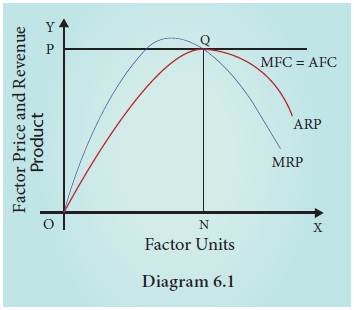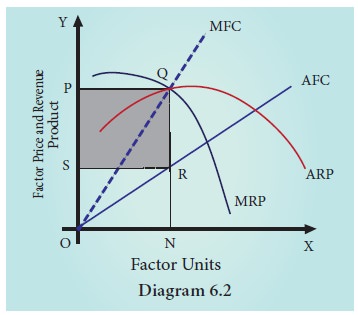Economics - Marginal Productivity Theory of Distribution | 11th Economics : Chapter 6 : Distribution Analysis
Chapter: 11th Economics : Chapter 6 : Distribution Analysis
Marginal Productivity Theory of Distribution
Marginal
Productivity Theory of Distribution
Introduction
Marginal
Productivity Theory of distribution was developed by Clark, Wickseed and
Walras. This theory explains how the prices of various factors of production
are determined. This theory explains how rent, wages, interest and profit are
determined. This theory is also known as “General Theory of Distribution” or
“National Dividend Theory of Distribution”.
Assumptions
This
theory is based on the following assumptions:
1.
All the factors of production are homogenous.
2.
Factors of production can be substituted for each
other.
3.
There is perfect competition both in the factor
market and product market.
4.
There is perfect mobility of factors of production.
5.
There is full employment of factors.
6.
This theory is applicable only in the long-run.
7.
The entrepreneurs aim at profit maximization.
8.
There is no government intervention in fixing the
price of a factor.
9.
There is no technological change.
Explanation of the Theory
According
to the Marginal Productivity Theory of Distribution, the price or the reward
for any factor of production is equal to the marginal productivity of that
factor. In short, each factor is rewarded according to its marginal
productivity.
Marginal Product
The
Marginal product of a factor of production means the addition made to the total
product by employment of an additional unit of that factor. The Marginal
Product may be expressed as MPP, VMP and MRP.
1. Marginal Physical Product (MPP)
The
Marginal Physical Product of a factor is the increment in the total product
obtained by the employment of an additional unit of that factor.
2. Value of Marginal Product (VMP)
The Value
of Marginal Product is obtained by multiplying the Marginal Physical Product of
the factor by the price of product.
Symbolically
VMP = MPP x Price
3. Marginal Revenue Product (MRP)
The
Marginal Revenue Product of a factor is the increment in the total revenue
which is obtained by the employment of an additional unit of that factor.
MRP = MPP x MR
Statement of the Theory
An
employer employs a factor of production because it is productive. So, the price
he wants to pay for the factor depends upon its productivity. The greater the
productivity of a factor, the higher will be its reward. If the price of a
factor of production is less
than its
marginal revenue product, the employer will use more of this factor, because
his profit will be increased.
When more
of a factor is employed, its marginal revenue product diminishes. But the
employer will gain by using additional units of the factor until the marginal
revenue product of the factor is equal to its price. The employer’s profit will
be maximum at this point. Beyond the point, the marginal revenue product is
less than the price of the factor. Hence, employer will suffer loss when he
uses more of the factor. Therefore, the conclusion is that the employer will so
adjust the price of the factor of production so as to equalize the marginal
revenue product of that factor.
In short,
the Marginal Productivity Theory of Distribution states that
a.
The price of a factor of production depends upon
its productivity.
b.
The price of a factor is determined by and will be
equal to marginal revenue product of that factor.
c.
Under certain conditions, the price of a factor
will be equal to both the average and marginal products of that factor.
The
Marginal Productivity Theory of
Distribution can be represented
diagrammatically
as follows:
Marginal Productivity under Perfect Competition

The
diagram 6.1 refers to the factor pricing under perfect competition in the
factor market. X axis represents factor units and Y axis represents the factor
price and revenue product. MRP is the Marginal Revenue Product Curve and ARP is
the Average Revenue Product curve. AFC is the Average Factor Cost curve and MFC
is the Marginal Factor Cost curve. AFC is horizontal under perfect competition
and MFC coincides with it.
When
there is perfect competition in the factor market, the firm is in equilibrium
(i.e., earning maximum profits) only when MFC = MRP. Hence, in the diagram, the
firm reaches equilibrium at point Q by employing ON units of factors and paying
OP price (NQ) where MFC = MRP. At the point Q, MRP = ARP. The price paid to the
factor (NQ) is also equal to marginal revenue product (NQ) and average revenue
product (NQ). This means that there is no exploitation of factors under perfect
competition. Beyond the point Q, no employer will employ factors, because after
that point, the price paid to the factor is more than marginal revenue product
and average revenue product.
Marginal Productivity Theory under Imperfect Competition
In
diagram 6.2 the factor pricing under imperfect competition is represented. AFC
is Average Factor Cost curve. It represents the price paid to the factors. It
increases as the number of factors demanded by the employer increases. As AFC
rises, MFC lies above AFC. It represents the marginal cost paid to the factors.
At the point Q, MFC = MRP, where the employer attains his maximum profit and so
he stops employment of the factors
at the
point. But the average cost paid is NRSO and the average revenue obtained is NQ
or OP. Total revenue obtained is NQPO. Therefore, exploitation per unit of
factor is RQ. But the total number of factors is ON. Thus, the total
exploitation of factor by the employer is RQ X SR = “PQRS” (shaded area). Thus,
under imperfect competition, factor is exploited at the equilibrium position.
Criticisms
This
theory is subject to a few criticisms
a.
In reality, the factors of production are not
homogenous.
b.
In practice, factors cannot be substituted for each
other.
c.
This theory is applicable only in the long–run. It
cannot be applied in the short-run.
Related Topics
